Dolcetto is a black wine grape variety widely grown in the Piedmont region of northwest Italy. The Italian word dolcetto means “little sweet one”, but it is not certain that the name originally carried any reference to the grape’s sugar levels: it is possible that it derives from the name of the hills where the vine is cultivated. In any case the wines produced are nearly always dry. They can be tannic and fruity with moderate, or decidedly low, levels of acidity and are typically meant to be consumed one to two years after release.
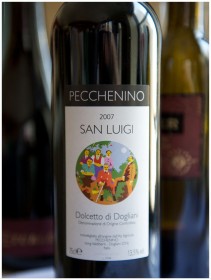 Dolcetto wines are known for black cherry and licorice flavours with some prunes and a characteristically bitter finish reminiscent of almonds. While the name implies sweetness, the wines are normally dry. The tannic nature of the grape contributes to a characteristic bitter finish.
Dolcetto wines are known for black cherry and licorice flavours with some prunes and a characteristically bitter finish reminiscent of almonds. While the name implies sweetness, the wines are normally dry. The tannic nature of the grape contributes to a characteristic bitter finish.
Recently our friend Diana, who runs the great B&B Baur in Aqui Terme, about an hour away from TorreBarolo, visited the town of Dogliani and these are her thoughts:
“A few weeks before Christmas my husband had the idea to take a ride over to the Langhe to taste some wines. He had a specific goal: he wanted to go to the Bottega del Dolcetto di Dogliani, the regional enoteca that is snuggled below the Municipio, right next to the splendid Chiesa dei Santi Quirico e Paolo in the heart of the city.
We had been to the enoteca before; it was from there that we visited the wonderful Chionetti winery for the first time in 2005. Dogliani was actually the center of our property search in 2001 and 2002 before we discovered our hill in the Monferrato. Contructed in the 12th century, Dogliani lies at the basin of the Barolo Valley. The nutrients and minerals that help the Nebbiolo grapes to flourish wash down to provide the perfect conditions for growing the Dolcetto grape. Of the eight zones officially designated to produce Dolcetto DOC, Dogliani is one of the top two. In 2005, Dolcetto Superiore di Dogliani received its DOCG status. With a minimum of 12.5% alcohol content and a hint of oak (the level depending on the winery) aging, Docetto has moved from a sharp, high tannin, low acid, quick-to-table wine with a slightly bitter residual flavor to a more rounded, softer wine that can sit in the bottle a few more years before being enjoyed with a variety of dishes typical to the region.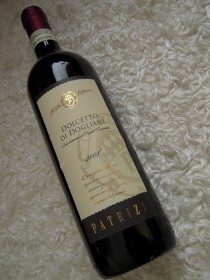
Enzo Romano, who runs the bottega, greeted us and helped Micha find the selection of wines he had been searching for. The Enoteca Regionale in Dogliani is one of the most organized and best run enoteche in the system. It has a current selection of all the producers in the appellation and a good breath of different vintages as well. Enzo helped Micha put together a healthy selection of twelve bottles of Dolcetto, both regular and superiore (wooded), for us to try. After trying, we notate the bottles we like the best and make appointments to visit those wineries.
An ideal combination of classic Piemontese food and wine might be. brodo broth made from winter capon served with boiled vegetables and agnolotti Piemontesi, alongside a 2008 Dogliani Bricco DOCG from the Cascina Minella, a vineyard brought to new life in 2002 by Livia and Gianluca Marchisio. I love this wine. It’s everything a good Dolcetto should be. It has character and bite without being agressive. Its 14% alcohol content and fullness of flavor speak of the patience and timing that the Marchisios exercised in picking the correct moment to harvest.
Dolcetto is not an easy wine to get right. We’ve been experimenting with the wine (from the tasting perspective) for years. To find dolcetto that truly maximizes the grape’s potential requires a producer with excellent soil conditions, the willingness to dedicate precious, southern exposure territory to a relatively humble wine, a sixth sense of timing regarding the harvest, the ability to stave off the many diseases this grape can contract and strong cellar knowlege. In our opinion, the two regions that have a concentration of these types of Dolcetto wineries are most likely to be found in Dogliani and Diano d’Alba.
Of course, there is tremendous enjoyment attached to searching out really spectacular wines from the bunch. Especially when that search takes you through some of the most bucolic and historic growing regions in Italy. We look forward to sharing our thoughts on the wines we’ve bought as we try them.”
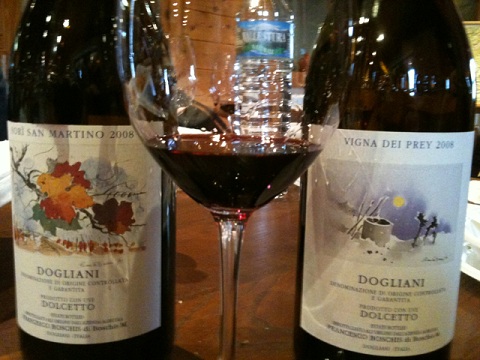
Franciacorta sparkling wine comes from Lombardy, with DOCG status produced from grapes grown within the area of Franciacorta, south hills of Lake Iseo, in the Italian Province of Brescia. It was awarded DOC status in 1967, the designation then also including red and white still wines. Since 1995 the DOCG classification has applied exclusively to the sparkling wines of the area.
Grapes for Franciacorta are grown in strictly delimited vineyards in the communes of Adro, Capriolo, Cazzago San Martino, Cellatica, Coccaglio, Cologne, Corte Franca, Erbusco, Gussago, Iseo, Monticelli Brusati, Ome, Paderno Franciacorta, Paratico, Passirano, Provaglio d’Iseo, Rodengo Saiano, Rovato and Brescia, with soil conditions described as mineral-rich, granular-sized, calcareous gravel and sandy morainal soils that cover a limestone bedrock.
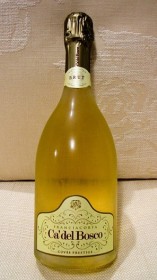 The DOCG declared vineyards extend 2,200hectares (5,400 acrres) and the distribution of permitted grape varieties are 85% Chardonnay, 10% Pinot nero and 5% Pinot bianco.
The DOCG declared vineyards extend 2,200hectares (5,400 acrres) and the distribution of permitted grape varieties are 85% Chardonnay, 10% Pinot nero and 5% Pinot bianco.
Nonvintage Franciacorta (NV) may not be released until at least 25 months after harvest, of which 18 months must be in contact with the yeast in the bottle (compared to 15 months in the case of Champagne). Franciacorta Vintage or Millesimato may not be sold until at least 37 months after harvest, of which 30 months must be in contact with the yeast (similar to Champagne). A Franciacorta rosé must contain at least 15% Pinot nero, and may be made by blending red wine. Franciacorta Satèn must be a Blanc de blancs with only the use of Chardonnay and/or Pinot bianco permitted, with only 4.5 atmospheres of pressure instead of 6.
Recently our friend and wine guru Gary Chevsky participated in a tasting event and these are his thoughts:
“On the heels of a great Champagne tasting this weekend at Santana Row’s Vintage Wine Merchants, I was itching for more sparkles. Kudos to Vintage for putting together an excellent line-up of Champagnes for a meager $40 ($25 for members) – they certainly packed the shop, and the punters were not disappointed.
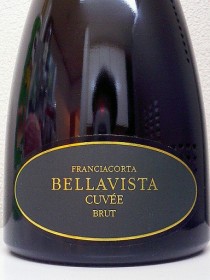 This was the first time I had the 1999 Dom Perignon, and it was probably my fave Dom P, showing the classical well-developed nuttiness. Compared to it, the just released 2002 was too young and simple at this stage. Other notables were the always reliable and incredibly inexpensive Hiedsieck & Co “Blue Top” ($25-30), the elegant Delamotte ($35, Salon’s little sibling), and the well-regarded higher-end Champagnes by Pol Roger (Reserve), Egly-Ouriet (Brut Tradition Grand Cru), and Gosset (Brut Grand Reserve).
This was the first time I had the 1999 Dom Perignon, and it was probably my fave Dom P, showing the classical well-developed nuttiness. Compared to it, the just released 2002 was too young and simple at this stage. Other notables were the always reliable and incredibly inexpensive Hiedsieck & Co “Blue Top” ($25-30), the elegant Delamotte ($35, Salon’s little sibling), and the well-regarded higher-end Champagnes by Pol Roger (Reserve), Egly-Ouriet (Brut Tradition Grand Cru), and Gosset (Brut Grand Reserve).
That was Sunday. On Monday, my faith in Champagne re-affirmed, it was now Italy’s turn to impress.
I am a big fan of Franciacorta. Italy’s answer to Champagne, it can be every bit as profound. Made in the traditional method (aka Champagne method) where the second fermentation and ageing on the lees take place in bottle, Franciacorta can evolve beautifully over many years, especially vintage examples, and can also be enjoyed young. Last night my wine/tennis group had a re-union (after I tore my achilles tendon earlier this year) at our local de-facto standard seafood hole-in-the-wall – the legendary Old Port Lobster Shack in Redwood City. To grease the wheels, we brought two of the most highly regarded Franciacorta producers – Bellavista and Ca’del Bosco. And the good news – Franciacorta, although being unknown in the non-wine circles, is readily available in this country. I got mine from WineChateau.com (Bellavista and Ca’del Bosco). Seafood, fries and sparkling wine – how can you go wrong with that combo?!
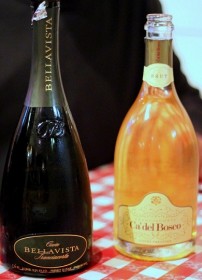 We didn’t. The Lobster Shack’s naked lobster roll is fabulous, and their beer-battered fish and chips are out of this world. But the dish that both Franciacortas really shone with was steamed mussels – petite, tender, flavorful in a great broth begging for dipped bread. Eric suggested that the wine really brought out the minerally tones in the mussels. I thought it went well even with the creamy New England clam chowder – another not-to-be-missed beauty from the Shack.
We didn’t. The Lobster Shack’s naked lobster roll is fabulous, and their beer-battered fish and chips are out of this world. But the dish that both Franciacortas really shone with was steamed mussels – petite, tender, flavorful in a great broth begging for dipped bread. Eric suggested that the wine really brought out the minerally tones in the mussels. I thought it went well even with the creamy New England clam chowder – another not-to-be-missed beauty from the Shack.
I gotta say – on a relatively quiet Monday night, we spent three hours chilling at this characterful joint. The folks there, especially the hostess Shay, are so friendly, she reminded me of my mom. Everyone had a great time, and with tongues un-tied, we reminisced of the old tennis follies and the crazy things that happen in the wine circles.
Bellavista is an old classic Franciacorta producer, and their non-vintage cuvee was a more serious expression than Ca’del Bosco’s floral and lemony entry level cuvee “Prestige” – an all-time dependable friend, that I always keep stocked in my cellar. Just for the heck of it, we followed with beers, and agreed that Franciacorta was a better, lighter, more elegant match. Enjoy!”
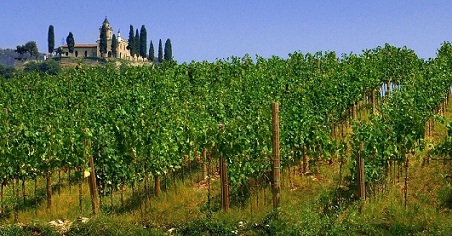

 Dolcetto wines are known for black cherry and licorice flavours with some prunes and a characteristically bitter finish reminiscent of almonds. While the name implies sweetness, the wines are normally dry. The tannic nature of the grape contributes to a characteristic bitter finish.
Dolcetto wines are known for black cherry and licorice flavours with some prunes and a characteristically bitter finish reminiscent of almonds. While the name implies sweetness, the wines are normally dry. The tannic nature of the grape contributes to a characteristic bitter finish.















